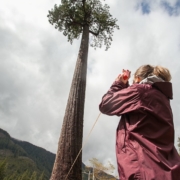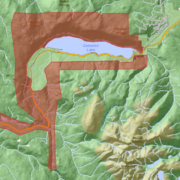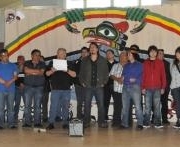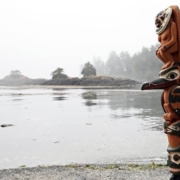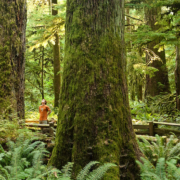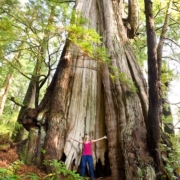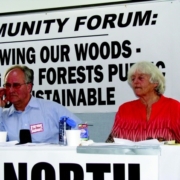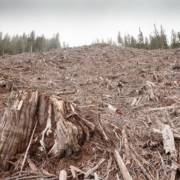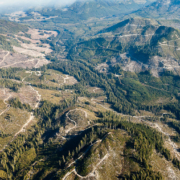Tofino — Tla-o-qui-aht First Nation celebrated the 30th anniversary of its declaration of a Tla-o-qui-aht Tribal Park on Meares Island with a gathering at Tofino Community Hall on April 20.
The 1984 declaration struck the first blow in a comprehensive fight to establish the right of First Nations people to protect their lands and resources, and by extension, those of their non-Native neighbours like Tofino. The April 21, 1984 declaration came about when monolithic logging giant MacMillan Bloedel (MB) announced plans to clearcut most of the forest cover on Meares Island, which is in the heart of Tla-o-qui-aht traditional territory.
While commemorating the efforts of those who launched and fought what was to become known worldwide as the War in the Woods, Tla-o-qui-aht used the occasion Sunday to extend the Tribal Park designation and its protections to cover its entire traditional territory.
Tla-o-qui-aht Beachkeeper Barney Williams Jr. greeted guests, who included many of the veterans, Native and non-Native, of the struggle. He explained that the concept of welcoming visitors is an important Nuu-chah-nulth tradition, but that it is implicit that visitors return that respect.
“For generations, our family has welcomed people over our beaches, and that tradition continues,” he said.
That welcome was freely extended to Europeans who arrived in the late 18th century, he noted. That they did not return that respect is a matter of history.
“We must remember that we’ve been here – and we’re still here,” he said. “We continue to extend the hand of friendship to those who come on our land.”
Moses Martin, current Tla-o-qui-aht chief councillor, was in 1984 the elected chief and living in Opitsat when the MB intentions were revealed.
“We met at Wickanninish School. It was Easter Sunday,” Martin recalled, adding that the gravity of the situation was obvious to all.
“I’ve spent a great deal of my time building relationships, and when you run up against something like that, it’s easy to get support from both First Nations and non-Native people. We had been working with the Friends of Clayoquot Sound, reviewing study after study of Meares Island.”
At the time, there were a lot of First Nations men working in the forest industry. It was well understood that a disruption in the industry would mean job losses for Tla-o-qui-aht members. Martin said even faced with that prospect, the loggers fully supported the new movement.
“Everybody was really on board, because the plan had 90 per cent of the island that was going to be logged,” he said. “We had seen that before, where whole mountains were clearcut. We didn’t want to see that here.”
Adding to the potential threat, Martin said, Meares Island is also the source of drinking water for Tofino. Clean drinking water flows from the island through an undersea siphon system. Unchecked logging would have destroyed the hydrology of the entire island.
In his address to the guests, Martin read off a long list of First Nations leaders, some, like the late Joe Mathias of Squamish First Nation, from across the country, who took part in the struggle, but are no longer living. The guests rose for an extended moment of silence to remember them.
“It was very easy to get that information out across the country,” Martin said. “We were able to get First Nations to come and support the work we were doing in Tofino.”
Guests also heard from some of the prominent non-Native stalwarts in the struggle, including Michael Mullin, who was on the front lines from the beginning.
“It has been an honour to be part of this, and to be in a place where people are proud of their place and look to their future and, with the leadership of the Tla-o-qui-aht, this was the first place in North America that people actually stood up to defend their land,” Mullin said.
“Meares Island was the first place where people turned back a logging crew, and the first time that people said, ‘This is our land, and we are going to assert our right to protect it.’ For that reason, Meares Island Tribal Park has been a leader and a model, not just for this country, but for the whole world.”
It was not just First Nations loggers who willingly gave up their livelihood to protect Meares Island. Lee Hilbert was an MB forestry engineer who realized he did not want to be complicit in the planned clearcut.
Hilbert was introduced by longtime friend and one-time logger Joe Martin.
“I was designing logging roads for MB,” Hilbert said. “I saw what was planned in this area in 1974, for the next 15 years, and it was going to be levelled.”
The plans he studied outlined a shocking progression of clearcuts across the entire countryside, including Meares Island, which, thanks to his friendship with Martin and his family, he knew to be considered sacred. It was then, he said, that he crossed the line from logging engineer to environmental activist.
“I quit the company. I found out where they were going to start, where the survey lines were. I called Joe and said, ‘You need to build a cabin right at Ground Zero,’ and he said I’d better talk to Moses.
“I called Moses and explained what I had in mind, to have a Native and non-Native community presence on the island, and he said, ‘I’ll be there and I’ll bring my boys.’”
Hilbert said by combining the energies of both the Native and non-Native communities, strengthened by traditional culture, what emerged was a “new tribe” dedicated to the preservation of Clayoquot Sound.
As MB finalized its plans for the Meares Island logging operation, the first protests took place in Tofino, then in Victoria. On the island where the road building was to begin, and where the log dump was to be located, people banded together to build a cabin to serve as a base camp.
Five months later, when the forest company sent in the first team of engineers and loggers to begin work in what they had officially dubbed Heel Boom Bay, they encountered a community unlike any previously assembled: people united to protect a pristine wilderness site.
In keeping with Nuu-chah-nulth tradition, Tla-o-qui-aht Chief Councillor Moses Martin welcomed the strangers onto the shore. But his words of greeting, which have now passed down into history, served notice that Nuu-chah-nulth lands and resources would be respected:
“You are welcome to come ashore and join us for a meal, but you have to leave your chainsaws in your boats. This is not a tree farm – this is Wah-nah-juss Hilth-hooiss, this is our Garden, this is a Tribal Park,” he told the MB delegation.
It was the beginning of an epic struggle that would eventually draw world attention to a small corner of the world known as Clayoquot Sound. The fight took place on the ground, in the woods, in the courts of law and in the court of public opinion.
The blockade lasted for five months. Then on March 27, 1985, the BC Court of Appeal ruled that there would be no logging on Meares Island until aboriginal land claims had been settled in the region.
At Sunday’s event, guests enjoyed an afternoon of traditional singing and dancing, including a song and dance that dates back to first contact.
Barney Williams explained that the song portrays how the first European visitors appeared, “On ships, surrounded by water. They had no land.” That snapshot of history has been preserved down to this day, he said.
Read more: https://www.hashilthsa.com/news/2014-04-22/tla-o-qui-aht-tofino-celebrate-tribal-park-declaration

